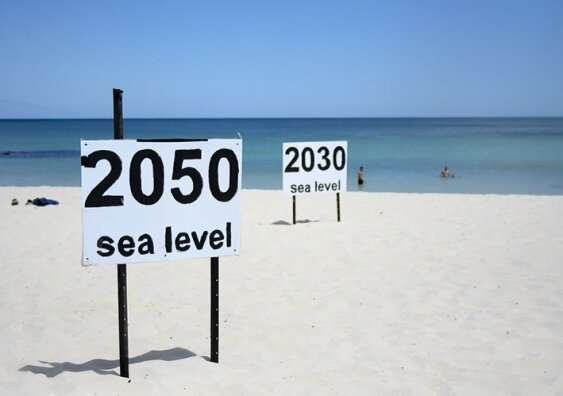- Aug 8, 2012
- 6,299
- 7,454
- 75
- Country
- Australia
- Faith
- Atheist
- Marital Status
- Divorced
Sea level data confirms climate modeling projections were right
by Lachlan Gilbert, University of New South Wales

The IPCC says sea levels could rise around 30-60 cm by 2100 even if greenhouse gas emissions are sharply reduced and global warming is limited to well below 2°C, but around 60-110 cm if greenhouse gas emissions continue to increase strongly. Credit: go_greener_oz, licensed under CC BY-ND 2.0
Projections of rising sea levels this century are on the money when tested against satellite and tide-gauge observations, scientists find.
Climate model projections of sea-level rises in the early 21st century are in good agreement with sea level data recorded in the corresponding period, a recent analysis has found.
And the scientists who crunched the numbers say the finding does not bode well for sea level impacts over coming decades if greenhouse gas emissions are not reined in.
In an article published recently in Nature Communications, the scientists from Chinese and Australian institutions including UNSW Sydney examined the global and regional sea level projections of two reports by the Intergovernmental Panel on Climate Change: the Fifth Assessment Report (AR5) and Special Report on the Ocean and Cryosphere in a Changing Climate (SROCC).
They compared the reports' projections with the observed global and coastal sea level data gathered from satellites and a network of 177 tide-gauges from the start of the projections in 2007 up to to 2018. The scientists found that the trends of the AR5 and SROCC sea level projections under three different scenarios of greenhouse gas emissions "agree well with satellite and tide-gauge observations over the common period 2007–2018, within the 90 percent confidence level."
More:
Sea level data confirms climate modeling projections were right (phys.org)
OB
by Lachlan Gilbert, University of New South Wales

The IPCC says sea levels could rise around 30-60 cm by 2100 even if greenhouse gas emissions are sharply reduced and global warming is limited to well below 2°C, but around 60-110 cm if greenhouse gas emissions continue to increase strongly. Credit: go_greener_oz, licensed under CC BY-ND 2.0
Projections of rising sea levels this century are on the money when tested against satellite and tide-gauge observations, scientists find.
Climate model projections of sea-level rises in the early 21st century are in good agreement with sea level data recorded in the corresponding period, a recent analysis has found.
And the scientists who crunched the numbers say the finding does not bode well for sea level impacts over coming decades if greenhouse gas emissions are not reined in.
In an article published recently in Nature Communications, the scientists from Chinese and Australian institutions including UNSW Sydney examined the global and regional sea level projections of two reports by the Intergovernmental Panel on Climate Change: the Fifth Assessment Report (AR5) and Special Report on the Ocean and Cryosphere in a Changing Climate (SROCC).
They compared the reports' projections with the observed global and coastal sea level data gathered from satellites and a network of 177 tide-gauges from the start of the projections in 2007 up to to 2018. The scientists found that the trends of the AR5 and SROCC sea level projections under three different scenarios of greenhouse gas emissions "agree well with satellite and tide-gauge observations over the common period 2007–2018, within the 90 percent confidence level."
More:
Sea level data confirms climate modeling projections were right (phys.org)
OB
Last edited:
